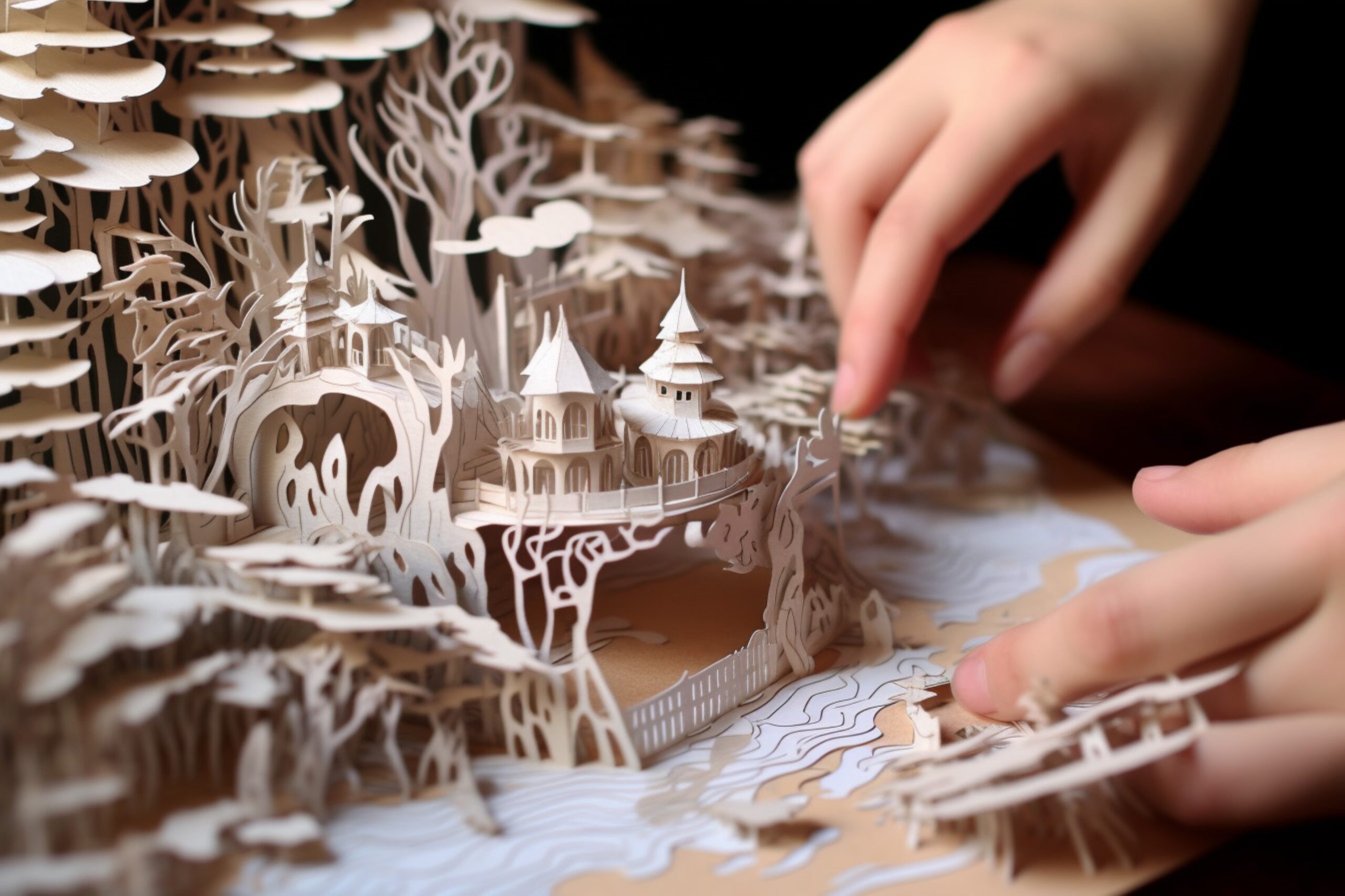In the intricate dance of blades and paper, there lies an art form that has captivated hearts and minds across the globe. Kirigami, a traditional Japanese practice of cutting paper into beautiful designs, is more than just an art—it’s a window into the soul of Japan’s rich cultural heritage. This journey into the world of Kirigami will unveil the magic hidden in a single sheet of paper, revealing its historical roots, the essential tools, techniques, and its undeniable influence in modern design. As we unfold the layers of Kirigami, we not only discover an art form but also a pathway to mindfulness and creativity.
1. Unfolding Kirigami: A Journey into Japanese Art
Kirigami, the Japanese art of paper cutting, presents a fascinating blend of simplicity and complexity. Its name is derived from the Japanese words "kiru" (to cut) and "gami" (paper). Unlike origami, which strictly involves folding, Kirigami introduces the element of cutting, offering a broader canvas for artistic expression. This art form transforms a flat piece of paper into intricate designs, ranging from symmetrical patterns to elaborate scenes. The beauty of Kirigami lies in its accessibility; all one needs to start is paper and a cutting tool. Yet, mastering it requires patience, precision, and a deep understanding of geometric principles.
2. Kirigami 101: Understanding the Basics
The essence of Kirigami is in its simplicity and the infinite possibilities it offers. Beginners often start with simple cuts to understand the interplay between positive and negative space. The process involves folding paper and making cuts based on patterns or freehand designs, then carefully unfolding it to reveal a masterpiece. Kirigami can range from decorative motifs to complex three-dimensional models. Understanding the basics involves familiarizing oneself with different types of folds and cuts, which serve as the building blocks for more advanced projects.
3. The History of Kirigami: From Ancient to Modern
Kirigami’s roots can be traced back to 6th century Japan, arriving with the introduction of paper from China. Initially, it was used in religious ceremonies and later evolved into a popular form of entertainment among the Japanese aristocracy. In the Edo period (1603-1868), Kirigami gained widespread appeal, with people creating and exchanging intricate designs as gifts. Over time, it has evolved, absorbing influences from across the world, and has found its place in modern art, education, and design, proving its timeless relevance.
4. The Tools of the Trade: Kirigami Essentials
The tools required for Kirigami are refreshingly simple, making it an accessible art form for enthusiasts of all ages. The basic toolkit includes sharp scissors or a precision craft knife, a cutting mat to protect surfaces, and paper. The choice of paper is crucial; it needs to be sturdy enough to hold the cuts but flexible enough to fold. Specialty papers like washi (traditional Japanese paper) are often used for their texture and durability. With these basic tools, anyone can embark on their Kirigami journey.
5. Mastering the Cuts: Techniques and Tips
Mastering Kirigami involves understanding various cutting techniques and how they interact with the folds. One of the fundamental skills is learning to control the blade, making precise and deliberate cuts. It’s also important to plan the design ahead, considering how each cut will affect the final piece. Experimentation plays a crucial role in Kirigami; even mistakes can lead to unexpected and beautiful results. Practitioners often advise starting with simpler projects to build confidence and gradually moving to more complex designs as skills develop.
6. Kirigami in Modern Design: A Creative Influence
Kirigami has transcended its traditional roots to influence contemporary design in areas such as architecture, fashion, and even engineering. Architects draw inspiration from Kirigami to create structures that mimic its dynamic, transformable nature. In fashion, designers incorporate Kirigami techniques to add texture and intrigue to fabrics. Moreover, engineers study Kirigami principles to develop materials that can stretch or contract, paving the way for innovations in wearable technology and beyond. Kirigami’s impact on modern design highlights its versatility and enduring appeal.
7. The Cultural Significance of Kirigami in Japan
In Japan, Kirigami is more than an art form; it’s a reflection of the country’s aesthetic sensibilities and philosophical outlook. It embodies the Japanese appreciation for minimalism, attention to detail, and harmony with nature. Kirigami also plays a role in education, teaching children about geometry, art, and patience. Festivals and exhibitions often feature Kirigami, showcasing its cultural significance and the artists’ technical prowess and creativity. Through Kirigami, one can gain insight into Japanese culture and its values.
8. Step-by-Step: Creating Your First Kirigami
Embarking on your first Kirigami project can be both exciting and daunting. A good starting point is to select a simple pattern, such as a snowflake or a floral motif. After choosing your paper, fold it according to the pattern’s instructions, then carefully cut along the designated lines. The magic moment comes when you unfold the paper, revealing your creation. It’s important to proceed slowly and enjoy the process, as Kirigami is as much about mindfulness as it is about artistry. With practice, even beginners can produce beautiful works.
9. Kirigami for Kids: Simple Projects to Start
Kirigami offers a wonderful opportunity for kids to develop fine motor skills, concentration, and artistic sensibilities. Starting with straightforward projects like paper animals or simple flowers can help build their confidence. It’s also a fun way to introduce children to Japanese culture and the broader world of art. Safety is paramount, so ensure that children are supervised and using appropriate tools. Kirigami can be a delightful family activity, fostering creativity and bonding through shared craftsmanship.
10. The Future of Kirigami: Trends and Innovations
The future of Kirigami is as dynamic as the art itself, with artists and innovators constantly pushing its boundaries. Interactive Kirigami, which incorporates elements of technology, offers new ways to engage with the art. Sustainability is another growing trend, with artists using recycled materials to create their pieces. As Kirigami continues to evolve, it’s likely to influence other fields in unexpected and exciting ways. The integration of traditional techniques with modern technology suggests a bright, innovative future for Kirigami.
11. Kirigami Galleries and Exhibitions Around the World
Kirigami has found a global audience, with galleries and exhibitions showcasing this art form worldwide. These events offer a glimpse into the versatility of Kirigami, from traditional designs to avant-garde interpretations. They also provide a platform for artists to share their work and for enthusiasts to appreciate the artistry and effort behind each piece. Attending a Kirigami exhibition can be an inspiring experience, illustrating the universal appeal of this Japanese art form.
12. Bringing Kirigami into Your Home: DIY Ideas
Integrating Kirigami into your home decor can add a touch of elegance and personalization. From creating your own wall art to designing unique greeting cards, Kirigami offers endless possibilities for DIY enthusiasts. It can also be a therapeutic hobby, offering a creative outlet and a way to unwind. With online tutorials and a plethora of patterns available, anyone can start incorporating Kirigami into their home, making everyday objects into works of art.
Kirigami, with its rich history and simple beginnings, continues to enchant and inspire. From its roots in Japanese tradition to its influence on modern design, Kirigami is a testament to the power of creativity and innovation. Whether you’re a seasoned artist or a curious beginner, Kirigami offers a world of possibilities, inviting you to explore the beauty and discipline of this exquisite art form. As we look to the future, Kirigami remains a vibrant and evolving practice, reflecting our enduring fascination with the transformative potential of paper.








